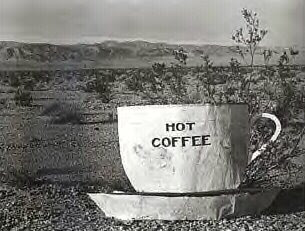
Even Pricey Espresso Makers Are Touted as Cheap Starbucks Alternatives
By JULIET CHUNG
Wall Street Journal
January 15th, 2009
As the economic slump puts the brakes on discretionary spending, kitchenware retailers and coffee-machine manufacturers are plugging everything from coffee beans to gleaming, $3,000 café-style espresso makers as ways to save money.
"Did you know cutting just one of those typical 'tall' lattes a day and replacing it with a delicious premium organic coffee you brew at home can save more than $1,200 a year?" goes a recent pitch in a news release from New Jersey coffee roaster Good Earth Coffee.
Reduced consumer spending has spelled trouble for the big coffee chains. Among the Starbucks customers who plan to spend less at the chain, 43% say they plan to brew coffee at home more often, according to research by Larry Miller, a restaurant analyst at RBC Capital Markets. That spells opportunity for the home-coffee-brewing sector.
Bodum, which makes French-press coffee makers and accessories like milk frothers, recently sent out a pitch saying users could save more than $1,000 a year making their coffee at home. Sales rose about 10% in 2008, says Bodum USA President Thomas Perez.
Philips Electronics, meanwhile, is touting its single-serve Senseo machine, which makes coffee from capsules, as an alternative to takeout coffee. It says the Senseo could, over five years, produce enough savings for a car down payment or a chunk of college tuition.
Even those who sell coffee machines costing $1,000 or more are stressing value. Sur La Table, a gourmet kitchenware chain, says its employees strive to help customers find the machine that best meets their needs. The chain has drip machines that sell for $100. But it specializes in fully automated coffee centers starting at around $1,000. The staff is told that "it's OK to let a customer know that if they're buying coffee every day at a Starbucks on their way to work, that that can quickly add up," says Jacob Maurer, a Sur La Table buyer.
"Value" advertising has typically flourished in downturns, says David Court, leader of the global marketing and sales practice at McKinsey & Co., but it can be a tricky sell. "Advertising works best when the message is incredibly simple," Mr. Court says. "The concept of value is a more difficult thing for the consumer to understand than 'Get a brand I know on sale.' "
Sales of coffee machines fell in 2008, but retailers say they are a relative bright spot amid sluggish consumer spending, and some say they are seeing only growth in the area. At Amazon.com, sales of single-serve machines, like the Keurig and Nespresso, as well as espresso machines, were up last year and outpaced the overall growth of Amazon's home and garden store, says Chris Nielsen, vice president of the category.
And some retailers are discounting heavily. Shoppers can find some coffee machines 25% to 50% off at Macy's and 20% to 35% off at Bloomingdale's.
Bloomingdale's saw a "double-digit-plus increase" in sales of single-serve machines and espresso machines last year, says Joe Laneve, senior vice president of home furnishings. At in-store demonstrations, the pitch focuses on how easy it is to brew a perfect cup of coffee, Mr. Laneve says. But he says the follow-up is, "By the way, if you're going to drink two or three Starbucks a day, this is a good way to save."
New investment in home coffee-brewing machines could have a lasting impact on $3-a-day latte habits, says Mr. Miller, the analyst. "I think you're going to see some of these folks not return to buying coffee outside the home."
Deb Trevino, a spokeswoman for Starbucks, which sells coffee machines and prepackaged coffee in its stores, says the chain recognizes that making coffee at home is an attractive option for customers. But, she adds, "our customers find value in coming to Starbucks" for the convenience and ambience. Even so, Starbucks has rolled out a loyalty card and other promotions that offer customers cheaper drinks.
Those who make coffee at home say they like the savings. Caroline Kauffman of Denver traded her daily grande chai tea latte for a Keurig machine that makes single cups of coffee and other drinks from capsules. With coupons, she pays about 40 cents a cup for coffee. "I don't go at all to Starbucks now," she says.
Not everyone is sold. New Yorker Marco Barontini indulges in an espresso out every day. Mr. Barontini, an independent money manager, says he thinks buying an espresso machine would save him money in the long run, but isn't interested in making a purchase. "It's just easier to stop in and pick up a cup," he said recently while visiting a Starbucks. "I like my convenience."
Originally printed in WSJ.com
Write to Juliet Chung at juliet.chung@wsj.com







